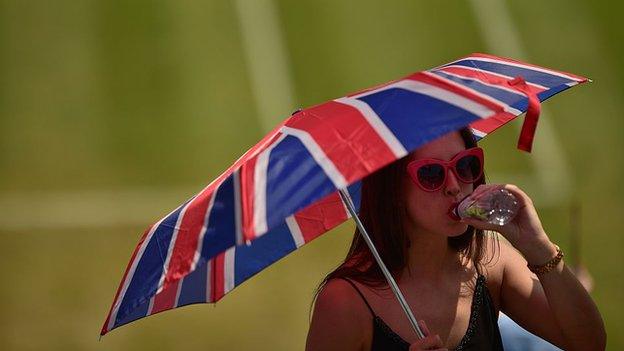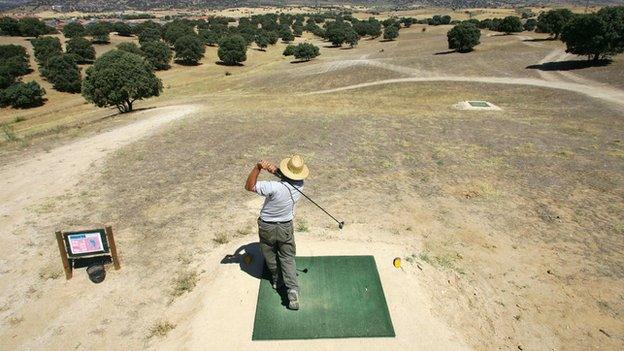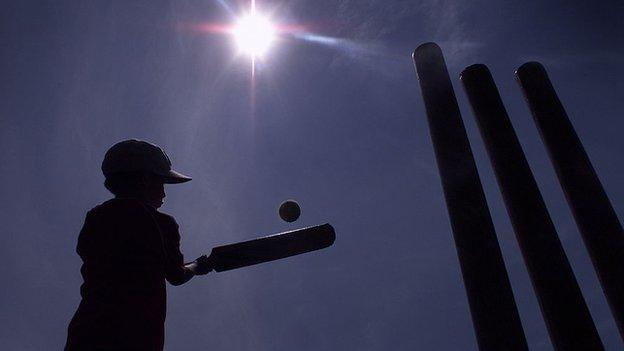Sport 2050: Climatecast - a weather forecast from the future
- Published
BBC Weather meteorologist Simon King looks at how the weather could impact sport in 2050.
Imagine a slow-motion replay of Rafael Nadal in action at Wimbledon, beads of sweat dripping from him, the sparse crowd frantically fanning themselves with sun hats, folded up programmes, anything they can find.
Now, picture an exhausted-looking James Anderson sluggishly stepping up to bowl in Australia's sweltering Melbourne Cricket Ground. Fielders searching for shade, concentration lapsing - the haze in front of them obscuring their view.
A few hardcore fans are in the stands, warm beer in hand, but most have left their seats already, either unable to cope with the harsh sun and smoky air - a by-product of area's wildfires - or preferring to watch on the TVs in the air-conditioned concourse.
Too dramatic? These are potentially common occurrences in the near future because of climate change and rising global temperatures.
This article is written using scientifically-backed Met Office projections, and provides a future vision of how avoidable climate change may affect sport.
(The information in this piece is based on forecasts for 30 years into the future and therefore includes a degree of uncertainty).
Tennis

Tennis will still happen - rain or shine
The quintessential British summer... It's hard to pinpoint isn't it. Rain showers? Scorching heat?
It's consistently inconsistent year on year, and only in recent times have us Brits experienced temperatures in line with sunnier parts of Europe - the State of the UK Climate Report in 2019 revealed the top 10 warmest years on record have all occurred since 2002.
But for sports fans, one constant (with the exception of 2020, of course) is the tennis at Wimbledon. Sometimes there are beautiful balmy days, and every now and again, a total wash-out.
But the Met Office's future modelling predicts play at the All England Club could become an all-too uncomfortable affair by 2050.
"The average maximum temperature expected during Wimbledon increases by 2.6C, from 20.7C in the 2010s to 23C in the 2050s.
"However, the highest maximum temperature experienced during the championships increases 4C, from 32C in the 2010s to 36C in the 2050s. A temperature of 39C to 40C is plausible in this period," say the team of climate science experts at the Met Office.
"As such, the potential impacts of heat stress on competitors and spectators will become an increasing issue.
"There will be a need for the championships to consider potential impacts from elevated heat conditions, however, events where a day of play will need to be suspended due to extreme heat risks will be very rare."
Golf

Quijorna Golf Club in Spain was built as an "ecological course", where if nature doesn't help out with rain, then the course is allowed to dry out and go brown.
Golf faces a moral dilemma.
Lush, green courses in warmer climes require more water than is sustainable.
Although many are using creative and innovative methods of saving water, it is sometimes tricky for them to justify using any sprinklers at all when parts of countries like South Africa are already experiencing long periods of drought.
The Met Office's modelling shows that there could be 50% more droughts towards the middle of the century than there are now due to lack of rainfall during the essential winter recharge period.
"Not only is it getting drier in the important winter season, when reservoirs recharge, but summers are also becoming drier [in South Africa] too," say the team of Met Office experts.
"This applies to the whole of the Western Cape, which may mean maintaining golf courses will be challenging in the future and prevent moving tournaments to other locations, like in 2018 [When the Cape Town Open was moved, external due to drought]."
At the other end of the spectrum, coastal courses in areas of high rainfall - including Donald Trump's Doonbeg in Ireland - are experiencing flooding from coastal erosion caused by rising sea levels.
That particular course has applied for permission to build rock barriers to protect its holes from the encroaching sea.
Baseball and other US sport

Houston Astros fans adopted the phrase #HoustonStrong after the devastation of Hurricane Harvey in 2017
In 2017, Hurricane Harvey caused catastrophic flooding and widespread damage to the city of Houston and surrounding towns.
Schools, hotels and homes were damaged and power outages lasted weeks in some areas.
Just over two months later, the Houston Astros won the World Series, despite having to play many of their home games in an alternative location.
The Met Office says cities where hurricanes are already frequent will continue to experience them due to oceans warming and sea levels rising.
This may result in more flooding on a similar scale to Harvey or worse.
Because of human activities such as groundwater abstraction (the process of taking water from a ground source), the city of Houston is sinking. On top of this, scientists are expecting to see a sea level rise of about 30cm on the adjacent Texas coast by 2050.
Football

Fifa brought in cooling breaks during the Women's World Cup in 2019
Heat stress is already a consideration for all major football tournaments.
Fifa had to introduce regular first and second-half cooling breaks for players at the Women's World Cup in 2019, which took place in France's relatively temperate climate.
There, temperatures reached 35C during the semi-finals, and stadium rules were relaxed in order to make sure fans were allowed drinks within the arenas.
Qatar 2022 will be the first ever winter tournament, with matches being played at night in order to avoid the hottest parts of the day.
So, are temperatures expected to rise further - 30 years from now?
With the example of our imagined World Cup in Guangzhou, China, 2050, heat could increase to a point where the number of possible match play-days would be dramatically reduced.
Compared with just 4% in the 2010s, a single model has suggested 38% of days would qualify as "extreme", with temperatures reaching over 36C and humidity levels over 30%.
These are considered unsafe playing conditions, although further projections from other models may bring this total down.
Overall, there is an 11% increase in the number of tournament days which require limits to play intensity such as shorter games and rolling subs.
Cricket
Cricket, particularly when played in the southern hemisphere, has arguably been one of the sports hit hardest by environmental issues.

During 2019's bushfires, Australia spinner Steve O'Keefe described the atmosphere as like smoking "80 cigarettes a day" and said they were "toxic" conditions to play in.
In 2018, England captain Joe Root was taken to hospital during the final Test of the Ashes in Sydney, when temperatures reached 47.3C.
According to the Met Office projections, things don't seem to cool off over the next 30 years.
Around Melbourne, there is an average 53% increase in the number of days that will require modification to playing conditions due to heat stresses by 2050 - that's about seven out of 21 playing days that could be interrupted in some way.
Further to this, there will be a 67% increase in the number of days requiring a suspension of play - that's three out of 21 days that could be suspended instead of two out of 21 days.
Cricket Australia says it is committed to supporting the sports industry globally to deliver collective progress on environmental sustainability.
Winter Sports

In April 2021 in Sierra Nevada, northern California, snowpack levels were at less than 60% of normal for the year
Poor snow conditions have blighted the World Cup ski circuit in recent years, with a number of races being relocated, postponed or cancelled in 2019 and 2020 - not just by global pandemics.
The Winter Olympics in Sochi was the hottest on record and it is predicted many of the former host cities will become unusable by the middle of the century.
The data analysed by the Met Office's climate science experts show that the number of days below zero will decrease by almost 30% by 2050 for Val d'Isere, a French Alpine resort that hosts a World Cup event.
Vicky Gosling, CEO of GB Snowsport, said: "There is no doubt that changing temperatures are going to have an impact on our athletes and training opportunities but we have to accept that that's secondary to the impact it is already having on the wider world.
"As a sport, we need to highlight and act on these sustainability issues to enable world-class performances, but also to preserve the nature of our sport for generations to come."
Climate Cast: Special thanks to The Met Office
In order to produce the Climatecast, BBC Sport and BBC Weather enlisted the help of The Met Office who conducted detailed research of the six sporting locations.
Using a mix of existing published material and their own climate modelling the team were able to produce comprehensive analysis which provided data for Simon King's forecast.
The Met Office's Dr Fai Fung led the team who produced the projections. He said: "Climate projections are the best window we have on our future world and looking through that window reveals that all aspects of our lives will be affected increasingly by climate change.
"Looking at major global sporting events is an interesting way of understanding the impacts of climate change on society and we find that we can't take the future viability of any of these events for granted.
"Cutting greenhouse gas emissions by nations around the world will avoid many but not all of the worst impacts of climate change on people, businesses and nature - including sport. The science shows that adaptation will also be needed alongside the emission reductions."
Special thanks to the Met Office team: Bernd Becker, Dr Dan Bernie, Dr Fai Fung, Dr Helen Hanlon, Prof. Jason Lowe OBE, Rachel Perks, Dr James Pope and Grahame Madge.
Matt McGrath explains why we should care about climate change (First published in 2015)